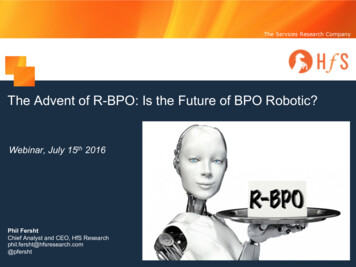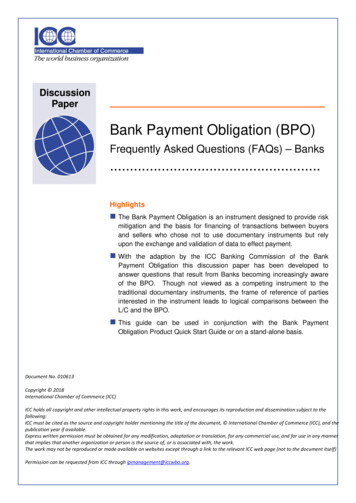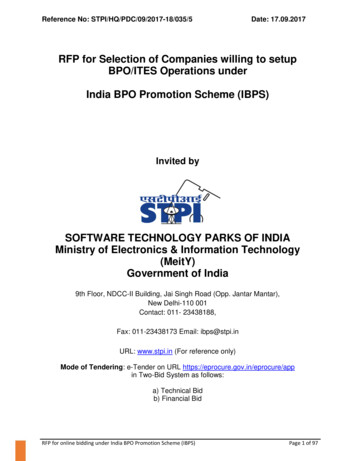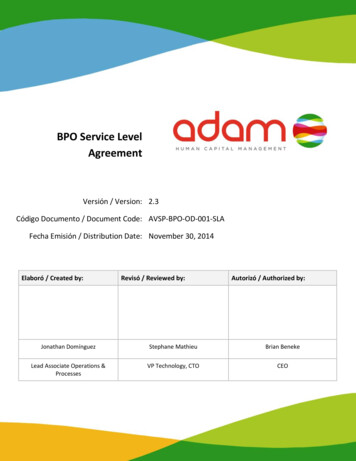
Transcription
The Services Research CompanyThe Advent of R-BPO: Is the Future of BPO Robotic?Webinar, July 15th 2016Phil FershtChief Analyst and CEO, HfS Researchphil.fersht@hfsresearch.com@pfersht
Phil Fersht, CEO and Chief Analyst, HfS ResearchOverview: 20 years’ business experience in the global IT and business processoutsourcing and shared services industryCoined the “As-a-Service Economy” in 2014Industry analyst, author, speaker, strategist and bloggerAdvised and cogitated on 100’s of global IT services, BPO andshared services engagementsMeddles with the largest global network of enterprise services andoperations professionalsCareer Experience:phil.fersht@hfsresearch.com Practice Lead, IT Services & BPO Research, Gartner, IncGlobal BPO Marketplace Leader, Deloitte ConsultingConsulting Practice Lead, IDC Asia/PacificIT Markets Practice Lead, IDC EuropeEducation: 2016 HfS ResearchBS with Honors in European Business & Technology, CoventryUniversity, United KingdomDiplôme Universitaire de Technologie in Business & Technology fromthe University of Grenoble, France
2016 HfS Research
HfS Research Has Been Writing About IntelligentAutomation for 4 Years 2016 HfS Research
The “Intelligent OneOffice” will emerge fromDigital AutomationThe Customer-first DigitalOrganizationThe Enabling IntelligentOneOffice DigitalUnderbellyThe DigitallyDriven FrontOfficeMobile,Social/Interactive, Realtime actionable data,Design ThinkingThe Nervous System,incepting & Processingall InputsIntelligentAutomation ofmanual processesDigitization ofdocumentsIoTIntelligentDigital SupportFunctionTheCircular SystemFront office-alignedIT, Finance, HR,Procurement,Supply ChainIntelligentDigitalProcessesTheNeural System 2016 HfS ResearchPredictive &OperationalAnalytics,Cognitive.
The Service Providers will bifurcateinto two groupingsOneOffice EnablersData Orchestration and HumanCollaborationBack OfficeOutsourcersEfficiency, Automation, LaborArbitrage and Scalability 2016 HfS Research
C-Suite operations directives focused on “more from less”How critical are the following C-Suite priorities/directives, in terms of shifting from a Cost Focus to aValue Focus with your operating model?Mission CriticalIncreasingly ImportantDrive down operating costs29%Accelerate speed to market with newproducts/services29%End-to-end process optimization26%Real-time data-driven 24%37%29%26%12%21%43%Source: HfS Research and KPMG LLP, 2015Sample: 168 Enterprise Buyer Executives from “Achieving Value Beyond Cost” Study, 2015 2016 HfS Research33%49%Better address risk and regulationRestrict the recruitment of labor wherepossibleInvest in process automation and robotics toreduce reliance on laborNot a Directive62%Cost effective, flexible servicesImprove the quality of operations talentEmerging5%9%16%35%38%
RPA use focused on IT currently, with F&A in a highadoption swingThinking about the use of RPA within the following business functions,what stage of maturity have you reached?Full scale RPAIT and Network infrastructure 10%IT application maintenance & 9%Finance and AccountingImplementing / using RPA actively23%23%6%Marketing23%10%Customer Service / Sales Support8%Supply Chain and Logistics8%SalesIndustry-specific Process (i.e. 9%8%19%21%19%17%18%Procurement8%17%Human Resources8%17%Source: “Intelligent Operations" Study, HfS Research 2016Sample: Buyers 371 2016 HfS Research
2016 HfS Research
How buyers would improve the quality andoutcomes from their current servicerelationships Letting go and giving up more higher-value work toour service provider(s)28%Threatening to entertain competitive bid(s) to forceyour current provider(s) to up their game13%Bring back more work in-house and improve itourselves9%Roll out an automation strategy in tandem with ourproviderBring in a specialist advisor to recalibrate ourrelationship(s) and get us on the right course for Asa-ServiceNot a lot – we paid for “cheap and cheerful” andthat’s what we’re stuck with45%4%2%Source: The HfS Working Summit for Service Buyers, December 2015(Sample 53 enterprise outsourcing leads)
RPA 1.0 2016 HfS Research
How HfS Defines Intelligent AutomationRobotic Process Automation describes a software development toolkit that allows non-engineers quickly tocreate software robots to automate rules-driven business processes.E.g. digitizing the process of collecting of unpaid invoices, that involves mimicking manual activities in the RPAsoftware, the integration of electronic documents and generation of automated emails to ensure the wholecollections, process is run digitally and can be repeated in a high-throughput, high intensity model.Cognitive computing is the simulation of human thought processes in an Intelligent Automation process or setof processes. It involves self-learning systems that use data mining, pattern recognition and natural languageprocessing to mimic the way the human brain works, without continuous manual intervention.E.g. an insurance adjudication system that assesses claims, based on scanned documents and available datafrom similar claims and evaluates payment awards.Autonomics is referring to self-learning and self-remediating engines, where the system makes autonomousdecisions, using high-level policies, constantly monitoring and optimizing its performance and automaticallyadapting itself to changing conditions and evolving business rules and dynamics. Increasingly minimal humanintervention.E.g. a virtual support agent continuously learning to handle queries and creating new rules/exceptions asproducts evolves and queries change.Artificial Intelligence is where intelligent automation systems go beyond routine business and IT processactivity to make decisions and orchestrate processes.E.g. an AI system managing a fleet of self-driving cars or drones to deliver goods to clients, manage aftermarketwarranties and continuously improve the supply chain. 2016 HfS Research
HfS Sees Intelligent Automation As-a-ContinuumCharacteristic of processtrigger basedrules basedstandardized languagerules baseddynamic languageSelf-learning & Self-remediationBPMWorkflowERPData CenterAutomation:RunbookScriptingSchedulingJob AVirtualizationCloud servicesCharacteristic of data/informationStructured 2016 HfS ResearchUnstructured patternedUnstructured without patterns
Intelligent Automation Continuum Expanding FastCharacteristic of processtrigger basedrules basedstandardized languagerules baseddynamic languageSelf-learning & Self-remediationBPMWorkflowERPData CenterAutomation:RunbookScriptingSchedulingJob AVirtualizationCloud servicesCharacteristic of data/informationStructured 2016 HfS ResearchUnstructured patternedUnstructured without patterns
Endgame: Vertically infused insights and data?!!Insights, DataMachine learning,Neural networks,Enterprise search,Artificial intelligenceAnalyticsVertically infusedinsights and dataBPaaS, BPO as-a-stack,Industry platforms. 2016 HfS ResearchVertical Processes
So We Need To Transform What Knowledge Work MeansNew JobsData Insight ManagerAugmentation IntegratorVisualization Interpretation"Bot" Employee OversightAutomation Overlord 2016 HfS ResearchEndangered JobsData EntryInvoicing / CollectionsAbstracting & IndexingData ReconciliationL1 Customer SupportMaster Data Management
Automation Impact Scenarios on Services Professionals by 2021Scenario 1Scenario 2Scenario 3ModerateLikelyAggressiveLow skilled jobsfalling by 22%Low skilled jobsfalling by 30%Low skilled jobsfalling by 36%Medium skilled jobsincreasing by 13%Medium skilled jobsincreasing by 8%Medium skilled jobsincreasing by 1%High skilled jobsincreasing by 57%High skilled jobsincreasing by 56%High skilled jobsincreasing by 55%Total jobs falling by2%Total jobs falling by9%Total jobs falling by14% 300,000 jobs at risk 1,400,000 jobs at risk 2,200,000 jobs at risk 2016 HfS Research
Impact of Automation on Services Jobs – Likely ScenarioLow Skilled Services JobsIT Services and BPO Employees(Millions)Medium Skilled Services JobsHigh Skilled Services Jobs16128.86.1840 2016 HfS Research4.85.21.72.720152021Impact Low skilled jobs falling by 30% Medium skilled jobs increasing by8% High skilled jobs increasing by 56% Total jobs falling by 9%Outlook Low skilled jobs phasing out toautomation throughRPA/Autonomics Starting to affect medium skills ascognitive computing augmentsthese skills Increasing demand for high skilledpositions involving creative problemsolving, analytics and criticalthinking
Total Impact of Automation on IT/BPO Services Workers byMajor Country (likely scenario, low-skilled workers)20152021% 0.730.67-10%0.740.54-5%0.00%Philippines 2016 HfS Research-20%UKIndiaUSResearch sources: 1477 industry stakeholder interviews 2015-16, NASSCOM,US National Bureau of Labor Statistics, UK ONS, Selected others, HfS Analyst judgment% Decrease in WorkforceServices Workers (Millions)2.5
Total Impact of Automation on IT/BPO Services Workers byMajor Country (likely scenario, mid-high skilled workers)20152021% .280.9410%0.41Philippines 2016 HfS Research20%1.270%UKIndiaUSResearch sources: 1477 industry stakeholder interviews 2015-16, NASSCOM,US National Bureau of Labor Statistics, UK ONS, Selected others, HfS Analyst judgment% Increase in WorkforceServices Workers (Millions)3.0
Total Impact of Automation on IT/BPO Services Workers byMajor Country (all skill-levels across all workers)2021% 902.01.0-10%1.54 1.47-15%1.00 1.080.0-20%Philippines 2016 HfS ResearchUKIndiaUSOtherResearch sources: 1477 industry stakeholder interviews 2015-16, NASSCOM,US National Bureau of Labor Statistics, UK ONS, Selected others, HfS Analyst judgment% Change in WorkforceServices Workers (Millions)2015
The PanelDavid PooleCo-founder and CEOSymphony VenturesIan BarkinCo-founder and Head of StrategySymphony VenturesJohnny RamondinoSenior Director Product ManagementADP 2016 HfS Research
This Game is Changing23 2016 Symphony Ventures – Confidential and ProprietaryOrchestrating the world’s work
Our Observations Regarding RPA Take-UpShared Services and GBS Direct / implementation partners Centers of excellenceBPO Clients taking a multi-channel approach Slow provider take-up and limited partnering strategyOutcome-based providers win over FTE-based providers Opportunity for digital innovation- In-house / specialist firms vs BPO providersRobotic BPO Pure Players24 Automation process specialists Implementation experience and capability extending into operate and run Extensive process model and object libraryHuman augmentation in exception handling and expert knowledge provision 2016 Symphony Ventures – Confidential and ProprietaryOrchestrating the world’s work
”As-a-Service” World-ClassWorld-ClassProcessProcess“Process as a service” – standardized world class processes utilizing leading SaaS tools, enablers and accelerators. RPAprovides the integrations between the tools and the interfaces to and from core legacy systems. Staff will handle the tasks requiringhuman intervention.25 2016 Symphony Ventures – Confidential and ProprietaryOrchestrating the world’s work
The Changing Landscape Driving BPO(Business Process Outsourcing)
ADP is transforming HCMInterconnectingTechnologywith Expertise2727Copyright 2016 ADP, LLC. Proprietary and Confidential.
Service delivery evolutionSupporting our clients throughout their lifecycle Supports all sizes of clients Manages differences incomplexity needs whenrequirements change Large geographic footprint Sustain and improve quality ofservice & speed of execution Optimize scope of servicesto improve value proposition Speed up transition to stablestate after major initiatives Rapid standup model Combined technology stack andservice teams Proven track record mitigatingrisks Controlled tAutomation Business case support Compensation planning, job/position codes, salary banding HCM integration andprocess improvement Wellness strategies Workforce planning Data driven decision support ACA cost and complianceanalysis, scenario modeling HR, Pay and benefitsregulations and best practicesCompliance& RegulatoryAffairsAcquisition& Carve outSupportCommunication& ChangeManagement28 Strategy & personalized toolsto educate employees andimprove engagement Change Management fororganizational, process andtechnology changes
The Services Research CompanyThe Advent of R-BPO: Is the Future of BPO Robotic?APPENDICESPhil FershtChief Analyst and CEO, HfS Researchphil.fersht@hfsresearch.com@pfersht
How HfS Defines Intelligent AutomationRobotic Process Automation describes a software development toolkit that allows non-engineers quickly tocreate software robots to automate rules-driven business processes.E.g. digitizing the process of collecting of unpaid invoices, that involves mimicking manual activities in the RPAsoftware, the integration of electronic documents and generation of automated emails to ensure the wholecollections, process is run digitally and can be repeated in a high-throughput, high intensity model.Cognitive computing is the simulation of human thought processes in an Intelligent Automation process or setof processes. It involves self-learning systems that use data mining, pattern recognition and natural languageprocessing to mimic the way the human brain works, without continuous manual intervention.E.g. an insurance adjudication system that assesses claims, based on scanned documents and available datafrom similar claims and evaluates payment awards.Autonomics is referring to self-learning and self-remediating engines, where the system makes autonomousdecisions, using high-level policies, constantly monitoring and optimizing its performance and automaticallyadapting itself to changing conditions and evolving business rules and dynamics. Increasingly minimal humanintervention.E.g. a virtual support agent continuously learning to handle queries and creating new rules/exceptions asproducts evolves and queries change.Artificial Intelligence is where intelligent automation systems go beyond routine business and IT processactivity to make decisions and orchestrate processes.E.g. an AI system managing a fleet of self-driving cars or drones to deliver goods to clients, manage aftermarketwarranties and continuously improve the supply chain. 2016 HfS Research
HfS Automation Labor Impact Model –Key Assumptions & MethodologyThis model predicts likely impact of the most recent wave of automation on the IT Services and BPOindustry. We estimate the current total IT Service and BPO employs c15 Million in 2015. With c3.5Million in India, c1 Million in Philippines, c5 Million in North America and c4 Million in Europe.The workers within the industry have been divided into 3 categories: low skilled, medium skilled andhigh skilled. With low skilled workers conducting simple entry level, process driven tasks that requirelittle abstract thinking or autonomy. High level workers undertaking complicated tasks that requireexperience, expertise, abstract thinking and autonomy.The model then applies underlying growth rates for each category linked to market growth. Eachscenario has a different set of parameters that will impact each level of worker setting out likely degreeof automation for each group and the probability that the job will be automated and in what timeframe this is likely to happen. There parameters are set out in full on the “Scenario Parameters” slide.The model then predicts the reduction in each level of the workforce based on the probability ofautomation within the scenario. This is taken from the underlying growth figure to produce a numberfor the work force at each level.The underlying growth rates assume current market growth will continue and is varied between thelevels based on demand – so given the increasing demand for higher level workers the underlyinggrowth in this category is larger irrespective of increases in automation. 2016 HfS Research
Automation is in the eye of the beholder
What is IASK?The Intelligent Automation Starter Kit is a specific workshop series for end-userorganizations.It provides a one-stop orientation for enterprise teams looking to understandIntelligent Automation technologies including the potential applications to theirbusinessTo get involved, email iask@hfsresearch.com 2016 HfS Research
About HfS ResearchHfS Research is the leading analyst authority and global network for IT and business services, with a specific focus onglobal business services, digital transformation, and outsourcing. HfS serves the research, governance, and servicesstrategy needs of business operations and IT leaders across finance, supply chain, human resources, marketing, and coreindustry functions. The firm provides insightful and meaningful analyst coverage of best business practices andinnovations that impact successful business outcomes, such as the digital transformation of operations, cloud-basedbusiness platforms, services talent development strategies, process automation and outsourcing, mobility, analytics, andsocial collaboration. HfS applies its acclaimed Blueprint Methodology to evaluate the performance of service andtechnology in terms of innovating and executing against those business outcomes.HfS educates and facilitates discussions among the world's largest knowledge community of enterprise servicesprofessionals, currently comprising 150,000 subscribers and members. HfS Research facilitates the HfS Sourcing ExecutiveCouncil, the acclaimed elite group of sourcing practitioners from leading organizations that meets bi-annually to share thefuture direction of the global services industry and to discuss the future enterprise operations framework. HfS providessourcing executive council members with the HfS Governance Academy and Certification Program to help its clientsimprove the governance of their global business services and vendor relationships.In 2010 and 2011, HfS Research's Founder and CEO, Phil Fersht, was named “Analyst of the Year” by the InternationalInstitute of Analyst Relations (IIAR), the premier body of analyst-facing professionals, and achieved the distinctive award ofbeing voted the research analyst industry's Most Innovative Analyst Firm in 2012.In 2013, HfS was named first in rising influence among leading analyst firms, according to the 2013 Analyst Value Survey,and second out of the 44 leading industry analyst firms in the 2013 Analyst Value Index.Now in its seventh year of publication, HfS Research’s acclaimed blog “Horses for Sources” is widely recognized as themost widely read and revered destination for unfettered collective insight, research, and open debate about sourcingindustry issues and developments. Horses for Sources today receives over a million web visits a year.To learn more about HfS Research, please email research@HfSResearch.com. 2016 HfS Research
Practice Lead, IT Services & BPO Research, Gartner, Inc Global BPO Marketplace Leader, Deloitte Consulting Consulting Practice Lead, IDC Asia/Pacific IT Markets Practice Lead, IDC Europe Education: BS with Honors in European Business & Technology, Coventry University, United Kingdom










